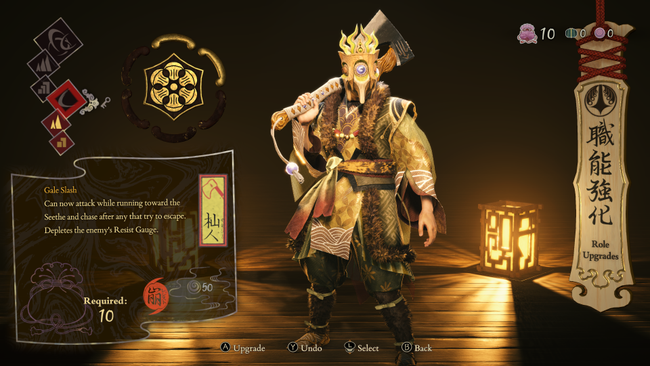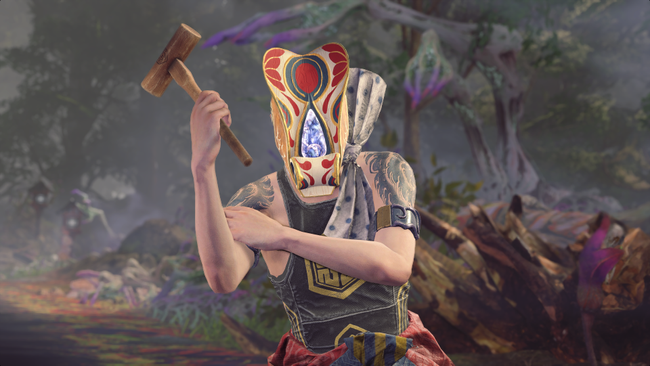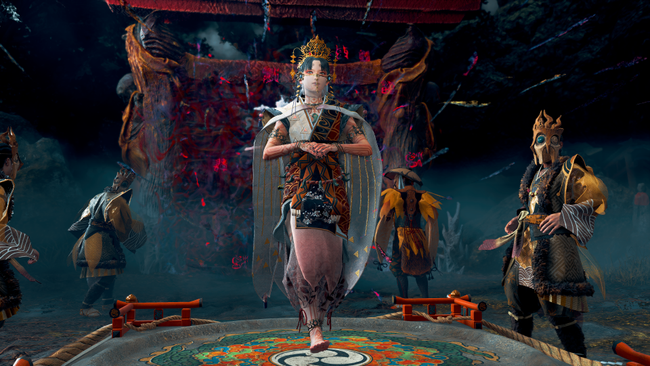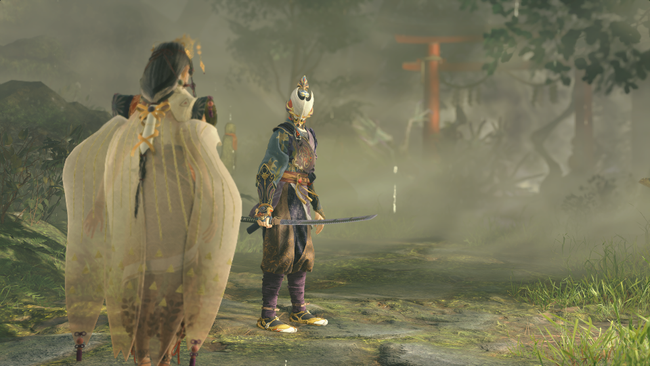
Kunitsu-Gami: Path of the Goddess Review
Much like the twin protagonists Yoshiro and Soh, Kunitsu-Gami: Path of the Goddess is a game stuck shuffling between dual identities. At the best of times its mix of Action RPG and Tower Defense work in tandem, harmoniously - yet what is ostensibly a great game is held back all the same due to moments where these disparate halves present as more of an identity crisis. Despite it all, Capcom delivers a game that you won't soon forget.
At its core, Kunitsu-Gami is a game about clearing a path for the incarnation of the "Goddess" of Kafuku mountain, Yoshiro, as she fulfills her duty to cleanse the holy mountain of Defilement and the "Seethe" that sprouts forth from it. To do so, you use energy derived from cleansing the environment and vanquishing enemies to carve a spirit path to the Torii gate at the end of a given level. Cocooned villagers inhabit many of the stages throughout the game, and once freed you can spend that same energy to equip the otherwise hapless civilians with magical masks that impart warrior abilities. Defeating special Festering Seethe will drop additional masks, which expands the variety of abilities you can grant to villagers; from simple vocations such as axe-wielding woodcutters and archers, to those sporting giant cannons, staves that can slow enemies in their tracks or cleanse them of buffs. Even otherwise passive spellcasters that can charge up an especially powerful spell that can damage every Seethe on the screen instantly. Some roles can even only be equipped to specific types of villagers, seemingly denoted by body type - requiring you to decide carefully which will be used, and where.

Each stage's structure will differ slightly, but the core premise of preparing during the Day so that you can be ready to tackle waves of Seethe emerging from defiled Torii gates during the night remains more-or-less the same for the entire runtime. The minutiae will change accordingly; some stages will task you to cut through a dark cave, requiring you to spend time lighting lanterns during the day to afford your villagers line of sight during the night. Others might force the player to bridge a body of water, in which case instead of carving a path forward, the game takes a much stricter tower defense role. The same can be said for missions where Soh loses their physical form, turning the objective into one of attrition - gathering enough energy to feed Yoshiro in order to regain Soh's form and clear the level. If there's one thing I commend Kunitsu-Gami for - it's how it understands that even though its base gameplay loop is strong enough on its own, there's merit and excitement for thinking outside the box with how players will tackle these stages. Some prioritize mastery of Soh's abilities, while others suitably stress your ability to build your defenses when you can only rely on the villagers to protect Yoshiro.
The latter of these stages require players to accustom themselves with the carpenter; a lone villager who specializes in repairing contraptions that can be found throughout stages. Sometimes these contraptions will start off in working order, while others require special attention. These can be platforms to give ranged units further range for their attacks alongside increased effectiveness, from barriers to slow down the Seethe, totems that buff all villagers stationed within its area-of-effect, and more.

Each stage has its own set of additional sub-objectives. Sometimes they'll be as simple as not using any healing items, preventing Yoshiro from taking any damage, or so on. Other times, they'll task you with more esoteric objectives such as destroying every pot in a stage; completion of these objectives will lead to additional rewards at the end of a stage, though you'll only unlock each reward the one time - making it far easier to re-attempt levels and focus on a specific objective without having to retread old ground. That's in addition to rewards players can claim from shrines for clearing each section of a level of all its defilement. New Game+ even adds a few new, harder objectives to each stage to tackle following the credits, with new enemy spawns to contend with, fitting the strength players would bring to the table with their upgrades to both Soh and the villagers' multiple roles.
These upgrades cost Musubi, which is a common reward for completing objectives during stages - but can also be found in black treasure chests that can be dug up with an otherwise useless Thief role during the day, or gifted for restoring stages that players have previously cleared. Every stage - every village - in the game can be revisited from the stage menu, and players can task any of the villagers that they rescued during the stage to work on restoring parts of the village per the player's wishes. Instead of restoration being an active process, players simply set the restorations they desire and complete stages to pass the timer. Sometimes these restoration projects will require materials, which can be found laying around the floor of the base, and villagers commanded to pick them up. It's a strikingly simple process, but the end result of seeing these stages brought back to their former glory is well worth it - even if the whole system feels like it betrays the team's history of working on mobile game projects. Every section of the village restored offers something in exchange, which is revealed up front to a degree; whether it's Musubi for upgrading your units, Ema plaques showcasing character models and a short bibliography, sweets for Yoshiro to snack on between stages - which doesn't impact gameplay - and more.

Upgrades and your load-out come in a variety of flavors, too. Early on players gain access to the ability to equip sword guards, special attacks that can be activated and provide an especially powerful skill before needing to be recharged again. It can be as simple as a set of swipes which will greatly reduce an enemy's Resist Gauge - eventually allowing it to be stunned, prompting a follow-up finisher which deals heavy damage, or overall susceptibility to basic attacks - buffs for the villagers, a barrier to protect Yoshiro, and more. These sword guards and Mazo Talismans can be equipped before stages, offering unique abilities or buffs depending on what the situation requires of you - ranging from simple stat increases, to more specific interactions like an attack boost that raises with the amount of energy available to Soh, the ability to recharge multiple of Soh's special Sword Guard skills at the same time, and much more. Alternatively, Musubi can be used as a currency to unlock semi-permanent upgrades. Eventually Soh can unlock the ability to use a bow, and further along access to special charged shots with unique effects; or special charged variants of combo finishers that can also deal heavy Resist damage. Or, even access to an entirely new base combat style, the ability to equip more Sword Guards and Mazo Talismans, and more.
Villager role upgrades are considerably simpler in scope, but at the same time can radically change the effectiveness of a given unit. What initially starts as basic HP and Attack upgrades can culminate in additional abilities that bolster a role in unique ways. The archer might be able to fire two arrows in quick succession, on top of any of its other buffs. In addition to drawing the attention of the Seethe, the Sumo Wrestler may gain the ability to weaken enemies with his stomps. Even if you find yourself disliking a given upgrade, you can undo a role's upgrades in-between stages with very little friction.
In normal stages, this gameplay loop feels satisfying. Regular enemies are weak enough that with enough preparation villagers can adequately protect Yoshiro, while leaving the stronger enemies to Soh's purview. Where the game falters, however, is in regards to some of the boss fights awaiting players during their trek down Kafuku Mountain and back up again, where the linear restrictions of these levels is lifted.

To put things bluntly, villagers feel strictly designed for the constraints of the Tower Defense gameplay of the regular stages. Meanwhile, bosses are predominantly designed more like an Action game; while most of them work just fine, there are a number of massive bosses that feel like they ask for a level of finesse with regards to commanding the villagers that the game's controls simply are not up for the task. Enemies with many, specific weak spots - requiring players to target them in order to deal damage, and who will quickly move themselves out of harms' way. Those whose attacks require you to command your units quickly to avoid death, when the most you can tell them is whether to attack a given area, or to stand by and defend it. There's an upgrade that lets you command all units to a specific location, but even that doesn't feel like a perfect solution. It's a mismatch with how these bosses are designed, and it's not like Soh's otherwise small moveset can fully counter the problem. Even if it could, instead of the stages where the game feels like it knowingly challenges you to make use of one half of its systems over the other, these bosses just feel a bit sloppy - and not particularly fun to fight, even if at the end of the day they're all relatively easy to defeat with some practice.
It's a massive blemish on an otherwise fascinating game, unlike anything else I've really played. Not one that makes Kunitsu-Gami a complete non-recommendation, but absolutely one that tempers my praise somewhat. Capcom has still delivered something special with this release, even if the rough edges are glaringly evident - the artstyle, the story delivered without any dialog, and the rest of the aesthetic in tow; even considering the problems with combat, level design always had something unique up its sleeve, forcing players to think on their feet to protect the one hope of containing the Seethe. Kunitsu-Gami: Path of the Goddess is a game that feels like it mimics the equally thorny path set upon its protagonists; despite whatever stumbles along the way, it's a journey you won't soon forget.